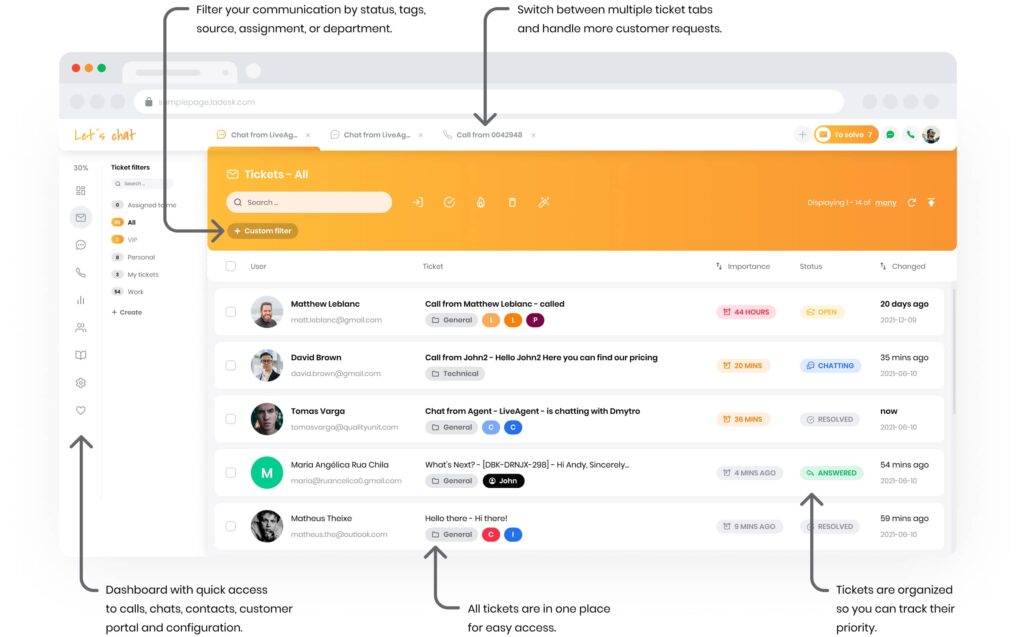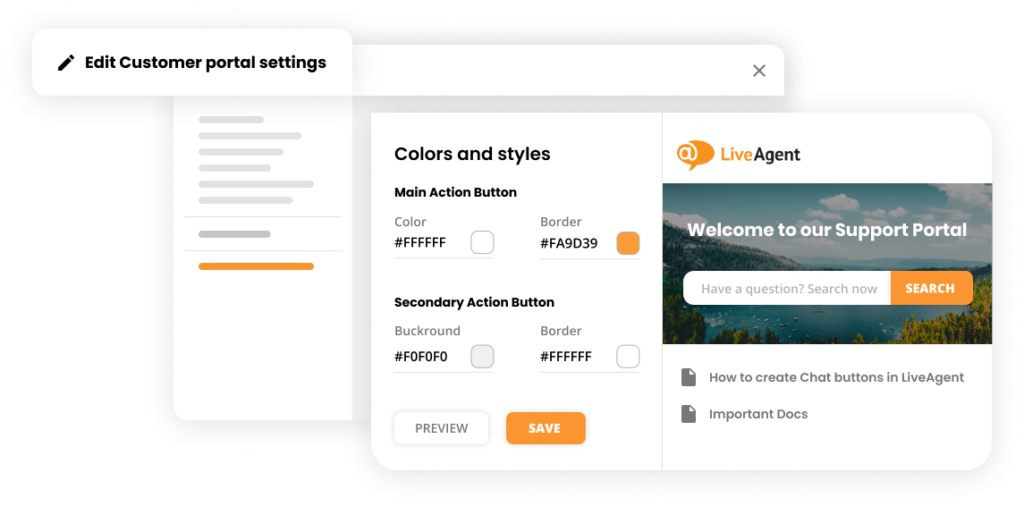What is the escalation management process?
The escalation management process creates measures to deal with potential customer challenges in customer service. These measures are also known as escalation paths and insure a company against customer dissatisfaction.
Escalation management focuses on customer satisfaction. It ranks customer service issues in order of severity and assigns them to the appropriate employee or customer service agent.
Most companies have an escalation document containing their escalation management process for different scenarios.
The escalation management process can be either reactive or proactive. Reactive escalation management deals with an issue after a customer complains. In contrast, proactive escalation management takes care of potential problems before they happen.
Why does escalation management matter in customer service?
No matter how great your customer support service is, there are bound to be a few lapses from time to time. Having a strategy for ticket and customer escalation management helps solve these lapses as soon as they happen.
Why might be escalation necessary:
- The customer’s initial contact doesn’t have enough knowledge or expertise to resolve the issue;
- The customer isn’t satisfied with a resolution and demands to speak with a higher authority on the team, e.g. the manager;
- There are too many queries, and the current customer support agent can’t attend to them as quickly as customers would like.
These are just a few of the many scenarios that could require an escalation procedure.
Escalation management is key to customer retention. Thus, it cannot be ignored in building a sustainable company. It is also an effective way to resolve customer conflicts quickly.
This is why you must use customer help desk software that integrates escalation management into its functions. This way, you can tackle your customers’ issues faster and provide them with quick solutions.
Types of escalation management
Different types of issues require different escalation paths. Based on this, escalation management falls into two main categories:
- Functional
- Hierarchical
Functional escalation management
Usually, customer support agents are equipped to deal with conventional conflicts with customers. However, when customers report complex issues that the agent cannot handle, the agent transfers them to the appropriate department. The process is known as functional escalation.
Hierarchical escalation management
Sometimes, grey zone conflicts might occur where the agent is not sure how to resolve a customer’s request. Instead of delaying the response, the best cause of action is to transfer the request up the chain of command to a supervisor. This is called hierarchical escalation management.
Hierarchical escalation management also applies when an automated support channel such as a scenario when a chatbot can’t effectively resolve a customer’s issue. In this case, the request should be transferred to an actual agent.
How do you handle escalation management with help desk software?
You might be asking what is customer service management escalation software’s benefit. A solution such as LiveAgent will make your escalation management process seamless. It ensures that every customer query is handled at the appropriate level of service. Here are specific ways it can help you do this:
Escalation management through ticketing
Ticketing is an important part of help desk software. It helps a customer service team manage customer requests in an efficient and organized manner. It creates catalogs for each customer request called a ticket.

The ticket can be easily and quickly transferred between agents when escalation is necessary. The LiveAgent software, for example, automatically converts customer service requests into tickets regardless of the communication. It also transfers tickets to the next agent on the escalation path after a specific time elapses without a resolution.
Escalation management through a call center
A call center is a centralized part of customer service that handles many phone calls from customers. This feature is commonly used by companies with many business contacts.
Escalation management through call centers involves transferring a customer’s call from the current call center agent to another.
Escalation management through live chat
Live chat allows you to handle customer queries via chat instead of emails or calls. The live chat feature enables escalation management by routing conversations automatically to the appropriate agent based on the customer’s query.
Escalation management through social media
LiveAgent help desk software facilitates escalation management through social media platforms like Facebook and Twitter by converting all notifications to tickets.

Your customer interactions are collected from all your social media platforms into the help desk tool and converted into tickets that are transferred to the right decision-makers in an escalation process.
Escalation management through a customer portal
A customer portal is a self-service tool that provides customers with complete access to information that might be relevant to their queries. This is especially useful if your customer service runs only on business days.

Customers can also reach out to an agent through the portal if they need more answers to their queries. In this scenario, the request is escalated to an agent. This feature also allows customers to give feedback that you can use to improve internal business processes.
Improve your customer service
LiveAgent gives you the power to answer all customer inquiries from one place making your customer service faster and more efficient. Curious about all the features?
Frequently Asked Questions
What is the escalation management process?
The escalation management process is the act of creating measures to deal with potential customer challenges in customer service by ranking issues in order of severity and assigning them to the appropriate employee or customer service agent.
Why does escalation management matter in customer service?
An effective escalation management strategy deals with lapses that may occur in customer service. It is key to customer retention and helps you build a sustainable company.
What are the types of escalation management?
Escalation management falls into two main categories: functional and hierarchical escalation management.
What does an escalations agent do?
An escalations agent handles escalated customer complaints, communicating with the customer and other team members to resolve issues satisfactorily. They document and analyze these issues to identify improvement areas in the customer service process. Their role is vital in managing customer escalations effectively and maintaining customer satisfaction.
How do you handle escalation management?
What is an escalation team?
An escalation team in customer service comprises expert agents or managers tasked with resolving escalated customer issues initially handled by customer service representatives. They are trained for complex issues and have both authority and resources for effective problem-solving, contributing to positive customer relationships and satisfaction. Moreover, they may devise strategies for reducing escalations and enhancing customer experience. Sometimes, automated technology supports this team in managing customer issues.
How do you email escalation to customers?
Customer escalation emerges when a customer is dissatisfied with the solution provided and seeks higher level assistance. When emailing escalation to customers, the focus should be empathy and finding a satisfactory resolution. It is important to outline previous steps, acknowledge faults, assure serious attention and provide an estimated timeline and contact point for further communication. The email should also include an apology and commitment to meeting customers' expectations.
Después de aprender sobre la gestión de la escalación, podrías estar interesado en explorar el proceso completo de escalación. En el artículo Escalation Process: Complete Overview, descubrirás cómo identificar factores de escalación y prevenir conflictos.
Además, si te enfrentas a clientes enojados, el artículo How To De-escalate An Angry Customer: Guide And Examples te proporciona técnicas efectivas para calmar situaciones complicadas. Aprenderás a manejar conversaciones difíciles con empatía y tranquilidad.
Provide excellent customer service
Discover unparalleled customer support with LiveAgent's all-in-one software. Benefit from 24/7 service, a free trial without a credit card, and seamless integration across 130+ ticketing features. Enhance your business with fast setup, AI assistance, live chat, and more. Choose LiveAgent for exceptional service and satisfied customers.
Landing PPC Archive - LiveAgent
Boost customer support with LiveAgent's all-in-one help desk software. Try free—no credit card needed! Live chat, ticketing & more!"

 Български
Български  Čeština
Čeština  Dansk
Dansk  Deutsch
Deutsch  Eesti
Eesti  Español
Español  Français
Français  Ελληνικα
Ελληνικα  Hrvatski
Hrvatski  Italiano
Italiano  Latviešu
Latviešu  Lietuviškai
Lietuviškai  Magyar
Magyar  Nederlands
Nederlands  Norsk bokmål
Norsk bokmål  Polski
Polski  Română
Română  Русский
Русский  Slovenčina
Slovenčina  Slovenščina
Slovenščina  简体中文
简体中文  Tagalog
Tagalog  Tiếng Việt
Tiếng Việt  العربية
العربية  Português
Português 




